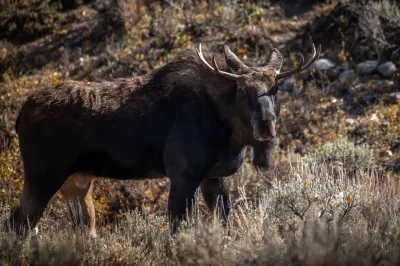Overly loud noise isn’t just a public health risk for humans.

A new study being conducted in the Bridger-Teton National Forest in Wyoming is finding that “the mere presence of human sound, no matter how loud or quiet, fast or slow, changes how animals behave.” Christine Peterson describes the new research in High Country News.
“For some species, hikers and bikers may be little more than a sideshow in a forest full of natural disturbances. For others, recreationists could have an impact similar to that of terrifying predators, invading habitat where food can be found, resulting in lower birthrates and even increasing deaths.”
While “non-consumptive recreation” such as hiking may seem harmless, “recent studies show otherwise. There’s one out of Vail, Colorado, showing that increased trail use by hikers and mountain bikers disturbed elk so much the cows birthed fewer calves. Another out of Grand Teton National Park showed that backcountry skiers scared bighorn sheep during winter when food was scarce, with potentially lethal consequences.”
The study is designed to assess what types of noises cause the biggest reactions in animals. “Judging by an initial analysis of last summer’s data, large groups of mountain bikers were the most likely to cause animals like mule deer and elk to flee.”
FULL STORY: When the Woods Get Noisy, the Animals Get Nervous

National Parks Layoffs Will Cause Communities to Lose Billions
Thousands of essential park workers were laid off this week, just before the busy spring break season.

Retro-silient?: America’s First “Eco-burb,” The Woodlands Turns 50
A master-planned community north of Houston offers lessons on green infrastructure and resilient design, but falls short of its founder’s lofty affordability and walkability goals.

Delivering for America Plan Will Downgrade Mail Service in at Least 49.5 Percent of Zip Codes
Republican and Democrat lawmakers criticize the plan for its disproportionate negative impact on rural communities.

Test News Post 1
This is a summary

Test News Headline 46
Test for the image on the front page.

Balancing Bombs and Butterflies: How the National Guard Protects a Rare Species
The National Guard at Fort Indiantown Gap uses GIS technology and land management strategies to balance military training with conservation efforts, ensuring the survival of the rare eastern regal fritillary butterfly.
Urban Design for Planners 1: Software Tools
This six-course series explores essential urban design concepts using open source software and equips planners with the tools they need to participate fully in the urban design process.
Planning for Universal Design
Learn the tools for implementing Universal Design in planning regulations.
EMC Planning Group, Inc.
Planetizen
Planetizen
Mpact (formerly Rail~Volution)
Great Falls Development Authority, Inc.
HUDs Office of Policy Development and Research
NYU Wagner Graduate School of Public Service





























